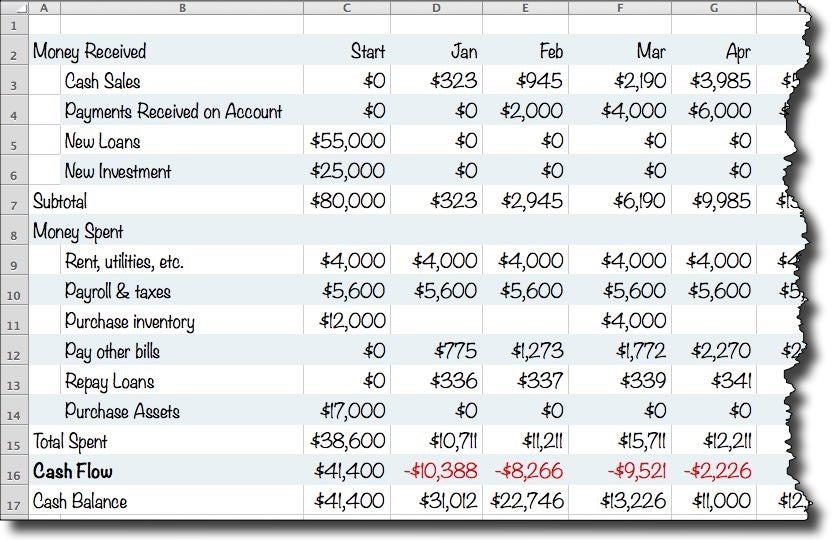
If there’s just one formal business skill every business owner should have, it’s understanding and forecasting cash flow. It’s not intuitive because it’s not the same as profits; but it’s vital. We spend cash, not profits. It’s one of the most important pieces of every lean business plan.
Here’s my recommendation for a relatively simple way to lay out cash flow in a spreadsheet, so you can see it. It doesn’t take a CPA or an MBA to do it … just knowing your own business. (Note: you can click on the image to see it full size, and you can find more variations with this search on the lean business plan site.)
Do Your Numbers
Making Your Estimates
- In lines 3 and 4, you forecast the revenue from sales. Yours might be just cash sales, a single line. If you have sales on account, you know it. If you’re not sure (maybe you’re looking at a startup so you don’t have the experience yet), assume you do have sales on account if you sell to other businesses; and probably not if you sell to consumers. Line 4 is your prediction for when the business customers will pay invoices.
- The ‘Start’ column reflects the starting balances and starting funding for a startup. With an ongoing business, you might have that balance labeled ‘Dec’ for the ending month of the previous year. In this example, the startup owner borrows $55,000 and gets $25,000 as new investment.
- Lines 5 and 6 are important because new money from loans and investments doesn’t show up in your profits, but it’s there.
- That whole block of rows 3-6 is a simplification. You know your business. Where else does money come in? Maybe you’re selling assets too? Stay flexible. Take this simple example as just that, an example. Make yours specific to your business.
- Rows 9-10 are also simplified. Use as many rows as you want to estimate operating expenses, focusing mainly on fixed costs, rent, utilities, and payroll.
- Row 11 is there to make the point that cash flow counts what you spend for inventory and other direct costs of sales, when you spend it—not when it shows up in profit and loss. When a bookstore spends $10,000 in November to buy books to sell, those books might not show up in profits (as cost of goods sold) until December, January, or beyond … but that money leaves your bank in November. So you put it into your cash flow in November. If you don’t sell products, and don’t deal with inventory, then you might have a row for direct costs such as hosting, or customer service.
- Row 12 is there because most businesses pay a lot of expenses at the end of the month, or 30-45 days after received. For example, the ad you place might come through as an invoice that you’ll pay later. Row 12 is for all those things you pay later. And, just in case you’re keeping track, these are expenses, including tax and interest. The projected interest on that $55,000 loan is included there.
- Rows 13 and 14 show two items that are often forgotten in cash flow planning. Principal payments on debts, and buying new assets, don’t show up in profit and loss. But they cost money that goes out of your bank account.
Simple Calculations
As you can see in the illustration, row 7 sums the money coming in, row 15 sums the money going out, row 16 shows the cash flow for the month, and row 17 shows the projected cash balance. You can see from the illustration how the cash flow is the change in the cash balance, and the cash balance is the equivalent of checking account balance; it’s how much money you have.
They Key is Using It Right
First, tailor your cash plan to match the actual details of your business. This is a very simple example. Be flexible about adjusting it so it matches your business, and your bookkeeping,
Second, using it correctly requires keeping it up to date. Review it every month. Calculate the differences between what you expected and what actually happened, and make adjustments.
You never guess right. And this is all guessing. What matters is watching carefully and updating so you can react to changes in time.
Like all business planning, the value is in the decision. The business value of cash planning is the decisions it causes.
(Ed note: I’m reposting here from my post yesterday on the SBA.gov Industry Word blog: A Simple Cash Flow Spreadsheet Anybody Can Use)













